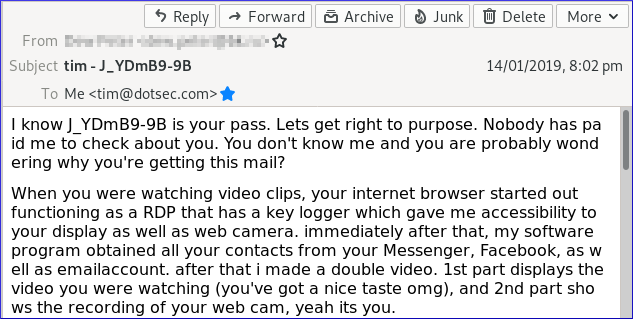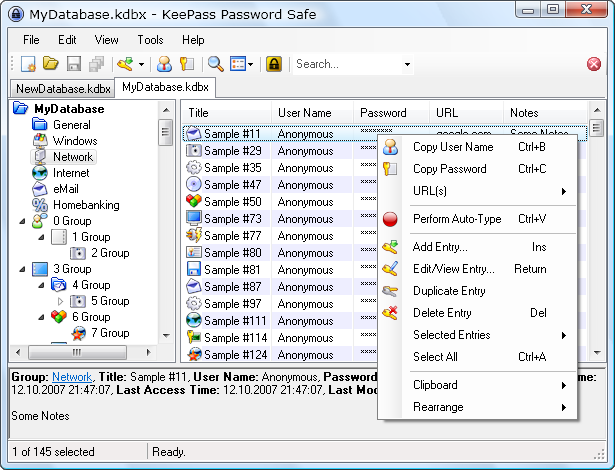Scareware v1 – Just silly… probably

Along with lots of other people on the Internet, you’ve probably received an unsolicited email, not only threatening you but claiming to have stolen your password and hacked your web cam. The emails generally go along the following lines:

While poorly worded, the email can certainly appear alarming and indications are that perhaps the attacker does have a password, and could really carry out their threat.
My first thought however was, “what rubbish!” I use two-factor authentication and even if I was worried about people’s perceptions of my browsing habits, my laptop camera doesn’t seem to be working…

…but still… that password in the email looks good and random… could it be one that I use or have used? A quick check on the Have I Been Pwned site and voila! There it is! It has been stolen! Now, was it my and if so, where did I use it? Another quick check, this time through the backups of my password-manager database and there it is again! It’s a password that I used on a brewing site that I frequented a couple of years ago; the site must have been compromised since I stopped using it but my account details must still have been lying about… unexpired and unencrypted… thanks site owners!
I’m stuffed!
So I know that the password was only used on an old brewing site which contains no PII or payment details, and I know that the attacker cannot access my accounts or my web cam. I can therefore be confident that this is just silly scareware which can safely be deleted.
But I might not be so cocky if I realised that I had reused the brew-site password elsewhere, especially if I had used it on a site that I really cared about like work, or perhaps Office 365. Why would I be more worried? Because then the attacker’s claim might be true. But even more worryingly, because when my username and password are stolen from one compromised site, they can be reused across multiple other sites in an attack known as credential stuffing.

Credential stuffing is a really common attack and in December and January this year (2019) we assisted three separate businesses who were all defrauded of around $40K, and at least one (perhaps all, it’s hard to be certain without proper logs) of those frauds started life as a credential stuffing attack. Basically, the victim had reused his/her username and password when setting up a range of on-line accounts, including personal and social-media sites, and his/her work Office 365 account.
Eventually, one of the sites on which the victim had an account was compromised, the attacker was able to steal the victim’s username and password for that site. The victim’s employer did not enforce two-factor authentication on the organisation’s Office 365 service so it was trivial for the attacker to log onto Office 365 with the reused credentials and masquerade as the victim, eventually defrauding the victim’s employer of around $40K.
That’ll do
To conclude, here are few take-away messages that are worth remembering:
- Don’t reuse passwords across different web sites and servers. The more I reuse a password, the more likely I am to suffer from a credential theft and stuffing attack. From once-off brewing-site breaches to real jackpots like the Collection1 example, we’ve seen password reuse results in outcomes ranging from mild inconvenience through to fraud worth over $40K. You need not just take our word for it though; other researchers have conducted extensive studies that show: If you reuse your password (and user ID) across multiple sites, you’re going to be done over… it’s just a matter of when. And they’ve also shown that we you get done over, you’re probably gonna pay… big time!
- Do use a password manager, and use it properly (where that includes secure backups, strong manager keys and/or passwords, and use on a secured host) so that it remains secure. Done correctly, a password manager precludes the need to remember or insecurely record or reuse passwords, greatly reducing the effectiveness of password-reuse (and silly scareware) attacks.
- If you run a business, move to two-factor authentication (2FA) and Single Sign-On (SSO). Seriously, the mechanisms and procedures to support 2FA and SSO have been around now for 20 years and it’s not a big deal… even social-media sites do it!

In a subsequent post, we’ll have a look and some not-so-silly scareware which has been used to try to extort money with the threat of destroying an entire organisation’s on-line reputation.
Until then, safe browsing!
